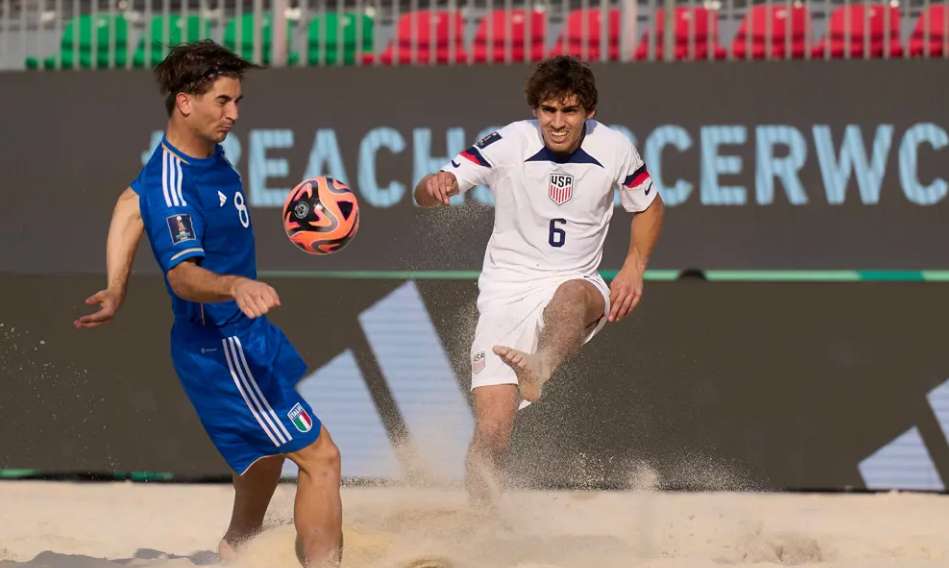Beach soccer, a variant of soccer played on sandy beaches, has gained popularity in various parts of the world due to its fast-paced nature, vibrant atmosphere, and its connection to the sun and surf. In America, the history of beach soccer reflects both the cultural influences of beach lifestyles and the evolving landscape of sports.

The roots of beach soccer in the United States can be traced back to the 1970s, a period characterized by a growing love for both soccer and beach culture. The combination of these two phenomena helped lay the groundwork for the sport's emergence. Initially, informal games were played along the coasts, often with friends and family enjoying the sun. These casual matches gradually evolved into more organized informal competitions as players sought to replicate the excitement they felt watching soccer games on television.
In 1992, beach soccer gained official recognition in the U.S. with the formation of the Beach Soccer Federation (BSF). This was a pivotal moment for the sport, as the organization aimed to promote beach soccer through tournaments and exhibitions. The first major tournament was organized on the picturesque beaches of Santa Monica, California, drawing attention from both local communities and the media. The event featured a mix of amateur and semi-professional teams, showcasing the sport's potential to engage spectators and athletes alike.
Throughout the 1990s, beach soccer began to grow steadily, primarily in coastal regions such as California, Florida, and Hawaii, where the combination of a laid-back lifestyle and a focus on outdoor activities created a fertile ground for the sport’s development. Competitions became more structured, with local leagues and tournaments offering a platform for players to showcase their skills. These early competitions not only highlighted the technical aspects of the game but also emphasized the sport's fun and social components, making it appealing to a wider audience.
The early 2000s heralded a new era for beach soccer in America, largely due to the influence of international competitions. The Beach Soccer World Cup, which started in 1995 and became a biennial event, served as an inspiration for American players and organizers. The U.S. national beach soccer team started to emerge in international competitions, gaining experience and visibility. Participation in these events allowed American players to compete at a higher level and learn from international counterparts, enhancing both skills and strategies.
In 2005, the establishment of the American Beach Soccer League (ABSL) marked another significant milestone in the sport's history. This league aimed to formalize the competitive landscape by bringing together teams from various regions to compete in a structured format. The ABSL played a crucial role in promoting the sport at both amateur and more competitive levels, helping to cultivate new talent and keep the excitement around beach soccer alive. Local clubs began to affiliate with the league, providing a pipeline for young players interested in pursuing beach soccer more seriously.
As the sport continued to evolve, media coverage and sponsorship opportunities began to expand. Major sports networks started to recognize beach soccer as an engaging spectacle, offering television exposure to both local and national tournaments. This visibility helped attract sponsors and create opportunities for players to earn recognition, further fueling interest in the game.
In addition to traditional beach soccer, variations of the sport emerged, including futsal and street soccer. These adaptations allowed players to hone their skills in different environments, contributing to the overall growth of soccer culture in America. The influence of global soccer phenomena, such as the popularity of Major League Soccer (MLS) and international tournaments like
the FIFA World Cup, also played a role in reinforcing American interest in various forms of the game.
The rise of social media in the 2010s further boosted beach soccer’s profile in the United States. Platforms such as Instagram and YouTube provided players, teams, and fans with outlets to share highlights, tutorials, and personal stories, helping to engage a broader audience. This grassroots promotion helped develop a community of beach soccer enthusiasts who organized their own events and promoted the sport locally.
Today, beach soccer in America continues to thrive, with numerous tournaments held across the country. Major cities such as Los Angeles and Miami regularly host competitions that draw players and fans from all over. Additionally, the U.S. national beach soccer team has participated in multiple international tournaments, helping to increase the sport's visibility on the global stage.
Looking ahead, the future of beach soccer in America seems promising. As the sport continues to gain traction, initiatives to involve youth participants, enhance coaching programs, and increase access to facilities are becoming central to its growth strategy. Organizations are working to develop partnerships with schools and community centers to introduce beach soccer as a fun and engaging activity for children, instilling a love for the game at an early age.
In conclusion, the history of beach soccer in America is a tale of evolution and adaptation, emerging from casual beach games to a recognized sport with organized competitions, national teams, and a dedicated community. As interest continues to grow, beach soccer stands poised to become an integral part of American soccer culture, celebrating the spirit of the beach along with the passion for the beautiful game.












